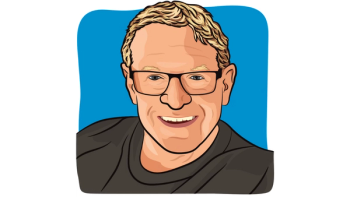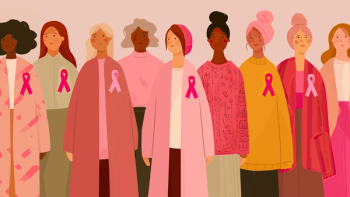
AI Used to Guide Prostate Cancer Treatment
A UCLA neurobiology professor and prostate cancer survivor discuss using artificial intelligence to map his disease and inform treatment decisions.
Artificial intelligence (AI) has the potential to “level the playing field” for patients with cancer, according to Joshua Trachtenberg, a professor of neurobiology at UCLA and a prostate cancer survivor.
“Many regional hospitals lack the access to equipment and depth of expertise that is common to large teaching hospitals like UCLA where we have interventional radiologists, urologists, surgeons, MRI, PSMA PET/CT imaging, among other things all in one place,” he said. “Thus, I imagine that patients outside of large metropolitan areas may have to seek, for example, MRI scans at one location and PSMA PET at another and may have to get their biopsies done at a third locale. The urologists at these regional centers — and, indeed, urologists everywhere — may find it difficult to holistically evaluate all of these tests. This results in confusion for the patient. AI can achieve this. This has the potential to bring much more sophisticated diagnosis and treatment plans to everyone, no matter where they live.”
For example, AI can help inform treatment decisions in prostate cancer — where, as Dr. Wayne Brisbane, assistant professor of urology and a urologic oncologist at UCLA Health explained, precision is key.
“There are some very important factors that run in and around the prostate,” said Brisbane. “One's the urethra, and the others are the neurovascular bundles, which are like telephone wires from the brain to phallus saying it's time for an erection, and those are running right alongside the prostate. The bladder is right behind the prostate and then there are the pelvic floor muscles, which are responsible for urinary continence and fecal continence, right at the apex if the prostate or the nose of the prostate.
“The prostate is kind of high-priced real estate or high-stakes real estate, and so where the tumor is relative to all those structures really indicates what kind of side effect profiles patients are going to experience when they're getting treatment. And so, knowing that with accuracy obviously is very important to know [when asking], ‘Can we treat this cancer?’ or ‘How do we treat this cancer best while minimizing side effects?’”
Tumors, Brisbane explained, are shaped like crabs, in that they have a central body as well as “a lot of legs that go out beyond the portion [of the tumor] that is visible on imaging, and that’s true for all imaging modalities [such as] MRI, PSMA, And these newer imaging modalities like microultrasound.”
Trachtenberg and his care team, which includes Brisbane, recently turned to artificial intelligence to navigate his prostate cancer treatment with the help of cancer-mapping tool Unfold AI, as he explained to CURE®.
Unfold AI, according to a news release from AI healthcare company Avenda Health, “combines patient-specific data from prostate imaging, biopsies and pathology into deep-learning algorithms to create a unique and tailored cancer estimation map. Its 3D, AI-generated map visualizes the location of the cancer for physicians to use in treatment decision making and interventional planning.” It was cleared for use by the Food and Drug Administration (FDA) in late 2022, according to Avenda Health.
“I can look at MRIs to understand basic anatomy,” said Trachtenberg. “But, I can't look at an MRI and identify where a lesion is. I can look at the Unfold AI (result) and get a very quick understanding of where the cancer is and where it isn't,” Trachtenberg said. “And that can help me very much understand my disease and what the path forward is.”
Trachtenberg’s care team utilized Unfold AI to support the use of precision medicine, also known as focal therapy, to treat his cancer with the TULSA Procedure, or TULSA-PRO, which uses ultrasound to create high temperatures and destroy prostate tissue.
Trachtenberg, whose father had also had prostate cancer, began having his PSA (prostate-specific antigen, a protein associated with the presence of prostate cancer) levels checked in his 40s, and watched his numbers slowly climb across a dozen or so years, before doctors discovered a lesion with a Gleason score (which grades prostate cancer based on a pathologist’s review of a biopsy or surgical specimen on a scale of 2 to 10) of 7 last March. Trachtenberg was weary of surgery and favored a watch-and-wait approach.
Learn more:
“If you do surgery, there's a lot of sexual side effects that come with surgery, and by side effects they mean you're not having sex,” he said. “I thought, ‘I'm 55, I'm not going down that route.’ And so, I thought, ‘You know, if it takes 20 years to die from this, yeah, 75's totally fine. It's fine. I'll take 75, and I thought, ‘Maybe I can do nothing about this, because there was no way [I was doing surgery]. And I then started reading a lot about more modern practices, using more focal therapies for killing localized tumors.”
Unfold AI was used to map the extend of Trachtenberg’s disease, a process Brisbane explained.
“By integrating multiple different information streams [such as] PSA, the age of the patient, their ethnicity, but also the biopsy core locations — these are little samples that we're taking — we know the extent of disease, and then through a machine learning algorithm, we can integrate all those information streams and predict with much greater degree of accuracy, where the legs [of the tumor] end so we can decide what's the best treatment, and then avoid collateral damage to the adjacent structures,” Brisbane said.
Trachtenberg is cancer-free three months later. Brisbane said Trachtenberg “really intuitively understood the benefits of integrating multiple data streams in order to make a prediction that's very accurate. … His particular lesion was in the upper portion of the prostate, which is tending to be away from a lot of the critical structures like the neurovascular bundles. But at that same time, he's a very young, very healthy guy, so we wanted to make sure that the entire tumor volume was encompassed by our treatments. So we used Unfold AI to predict the tumor extent and make sure that we accurately characterized the legs with the crab and proceeded to treatment.”
For more news on cancer updates, research and education, don’t forget to




